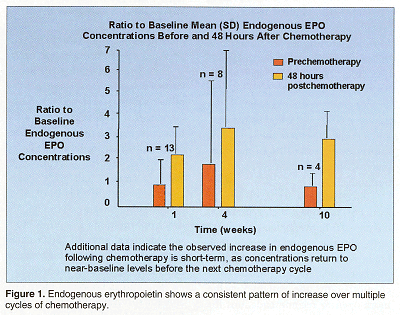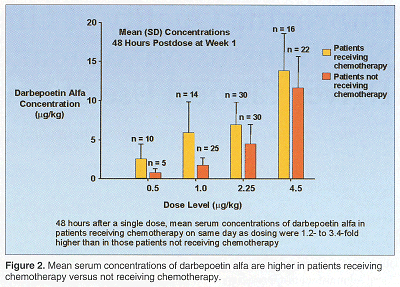Normalizing Hemoglobin Predicted to Slow Progression of Chronic Inflammatory Diseases
LOS ANGELES-Progress in treating cancer-related anemia has accelerated in the almost 20 years since the human erythropoietin gene was cloned. That was in 1983. Ten years later, the Food and Drug Administration approved epoetin alfa (Epogen, Procrit) for transfusion-preventing treatment of patients with anemia-complicating therapy.
LOS ANGELESProgress in treating cancer-related anemia has accelerated in the almost 20 years since the human erythropoietin gene was cloned. That was in 1983. Ten years later, the Food and Drug Administration approved epoetin alfa (Epogen, Procrit) for transfusion-preventing treatment of patients with anemia-complicating therapy.
Target hemoglobin levels "have been increasing as we get out of the transfusion age into the erythropoietic therapy age, and the perceived benefits in clinical trials have been increasing at the same time," reported John Glaspy, MD, MPH. He predicted that as new data emerge, "we are going to be able to demonstrate that normalizing hemoglobin is associated with improvements in other endpoints beyond quality of life, including survival in cancer patients and disease progression in patients with other chronic inflammatory diseases."
Dr. Glaspy is medical director of the Boyer Oncology Clinic and professor of medicine at the University of California School of Medicine in Los Angeles. He served as co-chair of the Fifth Quality of Life in Oncology Symposium.
"Much of our current knowledge of the biological and clinical significance of erythropoiesis grew out of research on patients with renal failure," Dr. Glaspy noted. "This is a much simpler model of anemia than cancer is, and it has given us incredible insights," although too often these have been ignored.
Cancer Patients Benefit
Since 2000, more attention has been focused on cancer-related anemia and its effect on patients’ quality of life. Studies, including controlled trials, ultimately demonstrated that cancer patients receiving human recombinant erythropoietin (rHuEPO) had improved quality of life and functional status.
Supporting data from three community-based studies show cumulative increases in the linear analogue self-assessment (LASA) QOL score over time as hemoglobin levels rise from 7 to 13 or 14 g/dL in patients treated with erythropoietic therapy. "Unlike what we in cancer research thought was the case, there appears to be a continued gain as we go from 10 to 13 g/dL," Dr. Glaspy noted.
Unresolved Issues
Several pivotal issues concerning anemia and erythropoietic therapy still need to be addressed, Dr. Glaspy said. "First, we need to learn more about the biology of anemia of chronic disease." A good starting point for debate is the role of relative iron deficiency, "defined as a patient whose erythropoiesis improves when you add iron to their treatment even if their iron indices do not suggest that they are total body iron deficient," he explained. "We don’t know what the optimal iron supplementation is to accompany erythropoietic therapy in cancer. The nephrologists, who have usually led us in the right direction, are using more and more parenteral iron, but we have yet to reproduce that in cancer patients."
Another important issue involves the metabolism of endogenous and exogenous EPO. For example, the observed increase in endogenous EPO following chemotherapy is short-term and levels return to baseline before the next chemotherapy cycle (see Figure 1).

A study with darbepoetin alfa (Aranesp) revealed higher mean serum concentrations in patients receiving chemotherapy than in those not treated with chemotherapy (see Figure 2). "It may be that we’ve been using the substances wrong by giving them on the same days as chemotherapy," Dr. Glaspy said. "We don’t yet know the optimal dose schedules and we argue a lot about the optimal target hemoglobins.’’

Other important issues that Dr. Glaspy said warrant further examination include cost and cost-effectiveness and the impact of therapy on survival, cognitive function, and chronic diseases other than cancer.